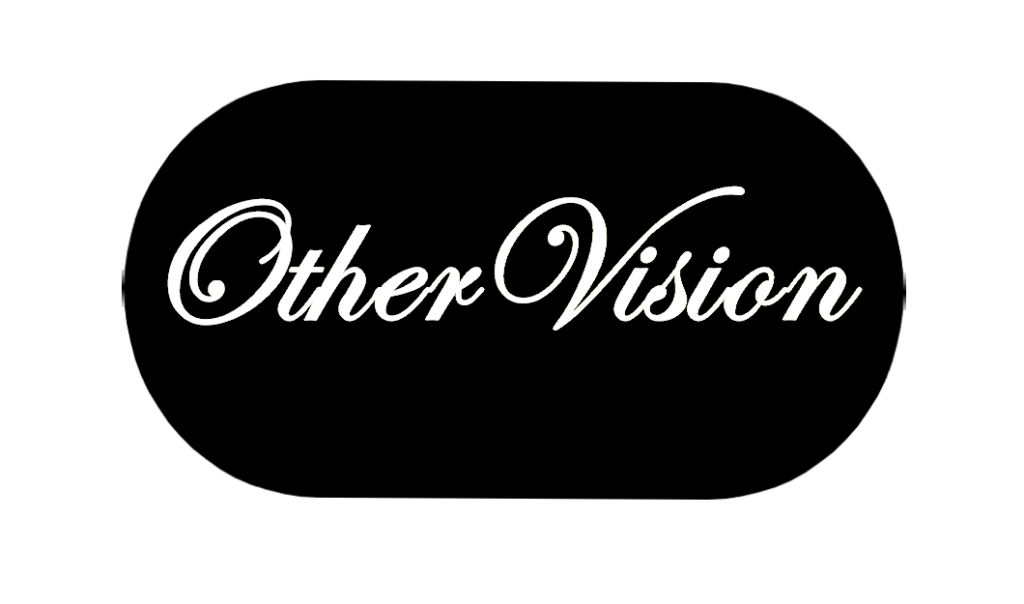IELTS Writing task 1 recent questions and sample answers.
Writing task 1: How recycled paper is made.
The diagram below illustrate how recycled paper is made.

Sample Answer:
The diagram elaborated how the whole process of recycled paper is made and by looking from an overall perspective, it is clear that the process includes 3 major levels beginning with initial collection and transport system which is then followed by cleaning and processing and last but not least the rolling will be the final product which will be man-made.
In order to produce recycled paper, we have to collect and transported this by a belt to a processing plant. Moreover, used paper will be turned into a pulp by using water and various chemicals. Henceforth, the pulp must then be filtered and before that water needs to be removes.
Once the filtration process concludes, the filtered paper pulp is directed through a tube into a container containing water and detergent for subsequent purification, as apparent to this the air it is introduced into the container to facilitate the removal of ink particles, afterwards, further cleaning ensues using a combination of water and specialized chemicals before proceeding to the final rolling stages.
Vocubulary Analysis:
The diagram elaborated how the whole process of recycled paper is made and by looking from an overall perspective, it is clear that the process includes 3 major levels beginning with initial collection and transport system which is then followed by cleaning and processing and last but not least the rolling will be the final product which will be man-made.
In order to produce recycled paper, we have to collect and transported this by a belt to a processing plant. Moreover, used paper will be turned into a pulp by using water and various chemicals. Henceforth, the pulp must then be filtered and before that water needs to be removes.
Once the filtration process concludes, the filtered paper pulp is directed through a tube into a container containing water and detergent for subsequent purification, as apparent to this the air it is introduced into the container to facilitate the removal of ink particles, afterwards, further cleaning ensues using a combination of water and specialized chemicals before proceeding to the final rolling stages.
Answers:
- Elaborated – means explained in more detail.
- Recycled – means converting waste into reusable materials for new products.
- Perspective – refers to one’s point of view or interpretation of a situation or concept.
- Transported – means moving or conveying something from one place to another.
- Henceforth – means from this point forward or from now on.
- Filtration – is the process of separating solid particles from a liquid or gas.
- Subsequent – means occurring or coming after something else in time or order.
- Purification – is the act of cleaning or refining something by removing impurities.
- Specialized – means designed or intended for a particular purpose or function.
- Processing – refers to the series of actions or steps taken to transform raw materials into finished products or to modify them for specific uses.
Writing task 1: High school/secondary school teacher salaries.
The table below gives information about salaries of secondary / high school teachers in five countries in 2009

Sample Answer:
The table demonstrates the salaries for secondary school teachers in five numerous countries in the year 2009. To begin with, it is clear and apparent that the teachers in Luxembourg generally earned the highest salaries which is similar to Korea and Japan, moreover, it required a long time to reach one’s highest salary. Henceforth, salaries in the other nations were comparable with Australia and Denmark requiring just a little more time to reach the notable top salaries.
In Luxembourg, the starting salary was $80,000 per year which is like higher than Denmark ($47,000), and all other countries which were approximately $30,000. The average salary per year displayed a coherencies way alongside Luxembourg which is known to be the highest standing at $112,000 and the other nations grouped tightly around $50,000 period.
In terms of maximum salaries, Luxembourg is once again on top of the mountain ($139,000) although the second place goes to Korea ($84,500), followed by Japan ($62,400), and then Denmark ($54,000), and after that the last place held by Australia ($48,000). Longest time for earing those hard case will be in Korea, Japan, and Luxembourg at 37, 34, and 30 years respectively.
Vocubulary Analysis:
The table demonstrates the salaries for secondary school teachers in five numerous countries in the year 2009. To begin with, it is clear and apparent that the teachers in Luxembourg generally earned the highest salaries which is similar to Korea and Japan, moreover, it required a long time to reach one’s highest salary. Henceforth, salaries in the other nations were comparable with Australia and Denmark requiring just a little more time to reach the notable top salaries.
In Luxembourg, the starting salary was $80,000 per year which is like higher than Denmark ($47,000), and all other countries which were approximately $30,000. The average salary per year displayed a coherencies way alongside Luxembourg which is known to be the highest standing at $112,000 and the other nations grouped tightly around $50,000 period.
In terms of maximum salaries, Luxembourg is once again on top of the mountain ($139,000) although the second place goes to Korea ($84,500), followed by Japan ($62,400), and then Denmark ($54,000), and after that the last place held by Australia ($48,000). Longest time for earing those hard case will be in Korea, Japan, and Luxembourg at 37, 34, and 30 years respectively.
Answers:
- Demonstrates – means to show or illustrate something clearly.
- Numerous – means many or a large quantity of something.
- Apparent – means easily seen or understood; obvious.
- Henceforth – means from this point forward or starting now.
- Comparable – means similar or alike in some way, allowing for comparison.
- Displayed – means to show or exhibit something, typically for others to see.
- Coherencies – refers to the quality of being logical, consistent, and connected in ideas or arguments.
IELTS task 1: The world’s forests
The pie charts give information about the world’s forest in five different regions.
Summarize the information by selecting and reporting the main features, and make comparisons where relevant.
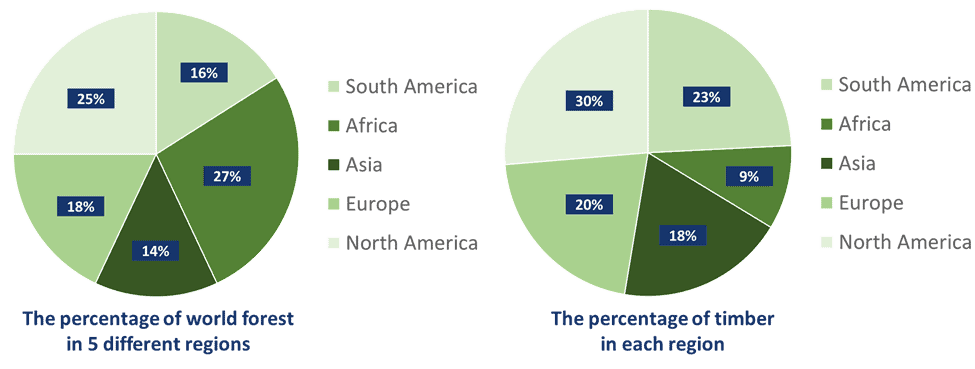
Sample Answer:
According each continent, the pie charts provide comprehensive information about the world’s forests and lumber. When considering the entire globe, it is easy to see that the majority of the world’s forests are found in North and South America, Africa, Europe, and Asia. On the other hand, North America has more timber than Africa.
Let’s start by saying that, North America and Africa at first the former covers up 25% of the world’s forest, while the latter makes up 27%. Furthermore, Africa has a far smaller percentage of timber which is 9%,, on the other hand, North America has a little greater percentage (30%).
In the other regions, the ratios from forest versus timber are more equal, in addition to this, 20% of the world’s timber and 18% of its forests are found in European countries. In terms of forests, South America is little lower at 16% and somewhat higher at 23%.; last but not least, 14% of the world’s total forests and 18% of all timber are found in Asia.
Vocubulary Analysis:
According each continent, the pie charts provide comprehensive information about the world’s forests and lumber. When considering the entire globe, it is easy to see that the majority of the world’s forests are found in North and South America, Africa, Europe, and Asia. On the other hand, North America has more timber than Africa.
Let’s start by saying that, North America and Africa at first the former covers up 25% of the world’s forest, while the latter makes up 27%. Furthermore, Africa has a far smaller percentage of timber which is 9%,, on the other hand, North America has a little greater percentage (30%).
In the other regions, the ratios from forest versus timber are more equal, in addition to this, 20% of the world’s timber and 18% of its forests are found in European countries. In terms of forests, South America is little lower at 16% and somewhat higher at 23%.; last but not least, 14% of the world’s total forests and 18% of all timber are found in Asia.
Answers:
- Continent – means a large landmass, like North America or Africa.
- Comprehensive – means complete and thorough, covering all aspects or details of a subject.
- Considering – means taking into account or thinking about something when making a decision or forming an opinion.
- Majority – refers to the greater part or number of something, typically more than half.
- Timber – means prepared wood for use in construction or other purposes.
- Former – refers to the first of two things or persons mentioned.
- Furthermore – is used to add information to what has already been said or written.
- Smaller – refers to something of a lesser size or extent compared to something else.
IELTS task 1: Dairy Production
This is an IELTS writing task 1 sample answer essay on the topic of dairy production by the world’s top 3 producers from the real IELTS exam.
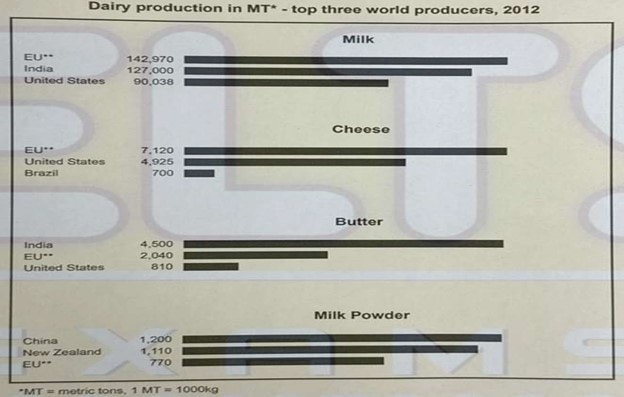
Sample Answer:
The bar chart illustrates dairy production for the top producers around the world in the year 2012. By observing all of the details I can be coherent that milk, cheese and butter were produced in a surging manner in the EU, India, the United States, and Brazil, milk powder which came mainly from China, New Zealand and the EU and the total production was highest by far for milk and lowest for milk powder.
In terms of milk production, the European Union (EU) stands out as the leading producer because they created 142,970 metric tons (MT) whereas it slightly surpasses India’s output of 127,000 MT and the United States’ 90,038 MT (which is pretty low compared to other two countries). Transitioning to cheese production, the EU continues to dominate by producing 7,120 MT while India and the United States contribute significantly to milk production, furthermore, they trail behind the EU in cheese production, highlighting the EU’s stronghold in both sectors.
For production of butter, India surpassed all other regions by producing 4,500 metric tons, double the figure of the EU (2,040) and more than 5 times higher than the United States (810) The EU was also involved in milk powder fabrication although they made just 770 MT.
Vocubulary Analysis:
The bar chart illustrates dairy production for the top producers around the world in the year 2012. By observing all of the details I can be coherent that milk, cheese and butter were produced in a surging manner in the EU, India, the United States, and Brazil, milk powder which came mainly from China, New Zealand and the EU and the total production was highest by far for milk and lowest for milk powder.
In terms of milk production, the European Union (EU) stands out as the leading producer because they created 142,970 metric tons (MT) whereas it slightly surpasses India’s output of 127,000 MT and the United States’ 90,038 MT (which is pretty low compared to other two countries). Transitioning to cheese production, the EU continues to dominate by producing 7,120 MT while India and the United States contribute significantly to milk production, furthermore, they trail behind the EU in cheese production, highlighting the EU’s stronghold in both sectors.
For production of butter, India surpassed all other regions by producing 4,500 metric tons, double the figure of the EU (2,040) and more than 5 times higher than the United States (810) The EU was also involved in milk powder fabrication although they made just 770 MT.
Answers:
- Observing – means watching or noticing something carefully and paying attention to details.
- Coherent – means clear and logical, with ideas or arguments that make sense and are connected.
- Surging – means quickly increasing or rising.
- Production – refers to the process of manufacturing or creating goods or services for sale or consumption.
- Surpasses – means to exceed or go beyond in quality, quantity, or degree.
- Transitioning – means the process of changing from one state, condition, or situation to another.
- Dominate – means to have control or power over something or someone, often by being the most important or influential.
- Contribute – means to give or provide something, often to help achieve a common goal or outcome.
- Significantly – means to a great extent or in a noteworthy manner, indicating importance or impact.
- Stronghold – refers to a place or position of strength or power, often used to describe a secure or heavily fortified location.
- Fabrication – means making or creating something, typically by assembling parts or materials.
IELTS Writing Task 1 : Free time activities of the elderly in the United States
Free time activities of the elderly in the United States from 1980 to the present
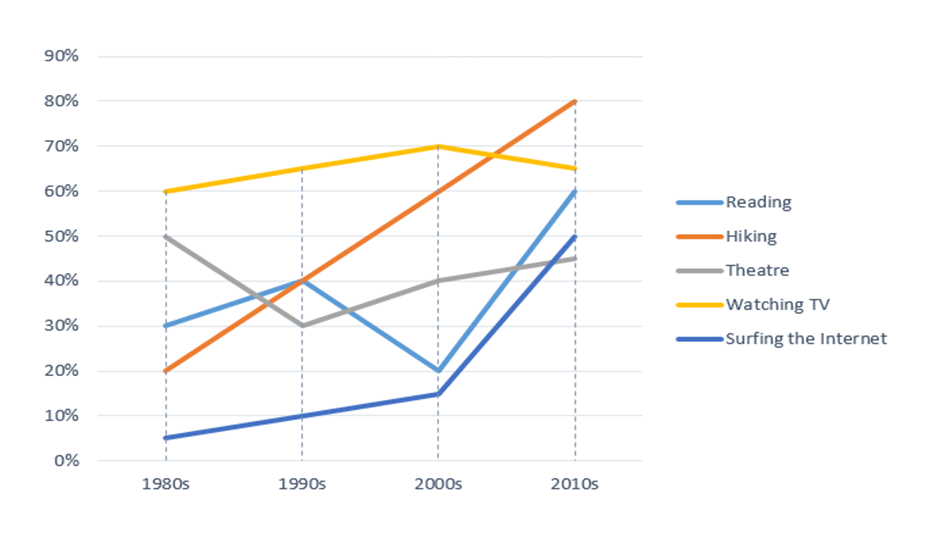
Sample Answer:
This graph illustrates the years 1980–present in the United States, illustrates the types of leisure activities engaged in by senior citizens. As we can see, the elderly are turning more and more engaged in the activities on the list. Watching TV continues to be the most popular activity overall, nevertheless hiking has been growing in significance with time.
Almost every activity saw an increase in popularity throughout the 1980s. Going to the theater was the lone activity that had lost popularity over the years. Attendance at theaters fell sharply from 50% to 30%.
In the year 1900, the other small factions, for example, going to the cinemas, reading stuffs, and browsing necessities in internet which increase in a gradual manner, on the other hand, watching tv programs declined quite a little bit because nobody these days prefers online platforms e.g. Netflix or Amazon Prime etc; yet this fragment still hold the second place in this notable group. Lastly, numerous elderly people are hiking these days in their spare time.
Vocubulary Analysis:
This graph illustrates the years 1980–present in the United States, illustrates the types of leisure activities engaged in by senior citizens. As we can see, the elderly are turning more and more engaged in the activities on the list. Watching TV continues to be the most popular activity overall, nevertheless hiking has been growing in significance with time.
Almost every activity saw an increase in popularity throughout the 1980s. Going to the theater was the lone activity that had lost popularity over the years. Attendance at theaters fell sharply from 50% to 30%.
In the year 1900, the other small factions, for example, going to the cinemas, reading stuffs, and browsing necessities in internet which increase in a gradual manner, on the other hand, watching tv programs declined quite a little bit because nobody these days prefers online platforms e.g. Netflix or Amazon Prime etc; yet this fragment still hold the second place in this notable group. Lastly, numerous elderly people are hiking these days in their spare time.
Answers:
- Illustrates – means to clarify or demonstrate something using examples, visuals, or explanations.
- Leisure – refers to free time for relaxation or enjoyable activities.
- Nevertheless – is used to introduce a contrasting point or idea.
- Attendance – refers to the act of being present at a particular event, gathering, or place.
- Necessities – are essential items or conditions that are required for survival, comfort, or success.
- Numerous – means a large number of something or many instances of something.
IELTS Writing Task 1 : Proposed Plan
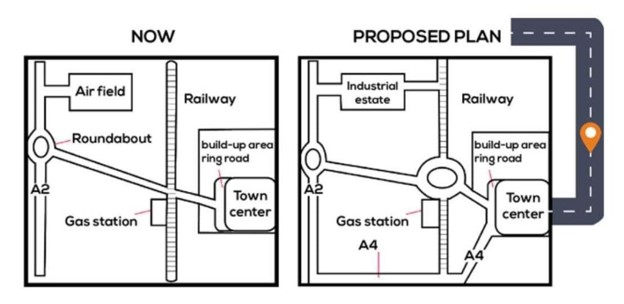
Sample Answer:
The map illustrates the current and future layout of a town with new roads leading to an increase in industrialization and transportation, subsequently, these modifications haven’t really affected the great majority of the town’s structures, for instance, a lengthy road (A2) extends southward and links to an airfield located to the northwest and we can see there’s a roundabout beside this route. After that, there’s another road that heads east and crosses a train near a gas station. The airfield would be replaced by an industrial building with a new road to the railway. In addition, the given development plan includes for relocating the roundabout to a somewhat southerly location.
In addition to the changes mentioned, there will be a new roundabout which is planned to connect rail tracks which will be seen near the fueling station. The town center, along with the developed region surrounding Ring Road will undergo no significant changes in the map of the future. Furthermore, a new road (A4) will extend from the town center in the west connecting and running along the southern boundary of the town, moreover, a single supplementary roadway will find it’s way in the map.
Vocubulary Analysis:
The map illustrates the current and future layout of a town with new roads leading to an increase in industrialization and transportation, subsequently, these modifications haven’t really affected the great majority of the town’s structures, for instance, a lengthy road (A2) extends southward and links to an airfield located to the northwest and we can see there’s a roundabout beside this route. After that, there’s another road that heads east and crosses a train near a gas station. The airfield would be replaced by an industrial building with a new road to the railway. In addition, the given development plan includes for relocating the roundabout to a somewhat southerly location.
In addition to the changes mentioned, there will be a new roundabout which is planned to connect rail tracks which will be seen near the fueling station. The town center, along with the developed region surrounding Ring Road will undergo no significant changes in the map of the future. Furthermore, a new road (A4) will extend from the town center in the west connecting and running along the southern boundary of the town, moreover, a single supplementary roadway will find it’s way in the map.
Answers:
- Industrialization – is the development of industries in a region or country.
- Transportation – is moving people or things from one place to another.
- Subsequently – means afterward or following in time or order.
- Modifications – are changes or alterations made to something, often to improve or adapt it to a different purpose or condition.
- Roundabout – typically refers to a circular road junction where traffic flows in one direction around a central island. It can also mean indirect or circuitous.
- Relocating – refers to the act of moving to a new place or position, often referring to individuals or businesses moving from one location to another.
- Surrounding – refers to the area or environment that surrounds a particular place or object.
- Supplementary – means additional or extra, often used to describe something that complements or enhances another thing.
IELTS Writing Task 1 : Average number of hours worked per week

Sample Answer:
The two graphs show different information about the number of hours performed and illnesses linked to stress for each of the eight professional groupings of people, for instance, lecturers usually work the fewest hours whereas businessmen are known for doing the longest shifts. The pie chart shows that, unexpectedly, teachers show the highest levels of work-related stress although having the shortest work hours. The bar graph illustrates that, average of roughly 70 and 62 hours per week each, businessmen and movie producers put in the most time at work. On the other hand, instructors put in the least amount of work which is about 25 hours a week. The hours worked by authors, programmers, doctors, lawyers, and chefs fall into different categories; they work approximately 52, 46, 35, and 32 hours each week, as well.
According to the pie chart, lecturers experience the highest rate of stress-related illnesses about 25% of them report having such problems. movie producers and doctors also have high stress levels, subsequently, businesspeople, attorneys, chefs, and authors stress range from 11% to 8%. Programmers, astonishingly, have the lowest rate of stress-related illness just 5% which is like far lower than that of lecturers.
Vocubulary Analysis:
The two graphs show different information about the number of hours performed and illnesses linked to stress for each of the eight professional groupings of people, for instance, lecturers usually work the fewest hours whereas businessmen are known for doing the longest shifts. The pie chart shows that, unexpectedly, teachers show the highest levels of work-related stress although having the shortest work hours. The bar graph illustrates that, average of roughly 70 and 62 hours per week each, businessmen and movie producers put in the most time at work. On the other hand, instructors put in the least amount of work which is about 25 hours a week. The hours worked by authors, programmers, doctors, lawyers, and chefs fall into different categories; they work approximately 52, 46, 35, and 32 hours each week, as well.
According to the pie chart, lecturers experience the highest rate of stress-related illnesses about 25% of them report having such problems. movie producers and doctors also have high stress levels, subsequently, businesspeople, attorneys, chefs, and authors stress range from 11% to 8%. Programmers, astonishingly, have the lowest rate of stress-related illness just 5% which is like far lower than that of lecturers.
Answers:
- Performed – means to carry out or execute a task, action, or activity.
- Unexpectedly – means in a way that is not anticipated or foreseen, surprising or catching someone off guard.
- Approximately – means nearly or roughly, indicating an estimated or close value without being exact.
- Subsequently – means happening or occurring afterward, following in time or order.
- Astonishingly – means in a manner that causes great surprise or amazement, unexpectedly or remarkably.





